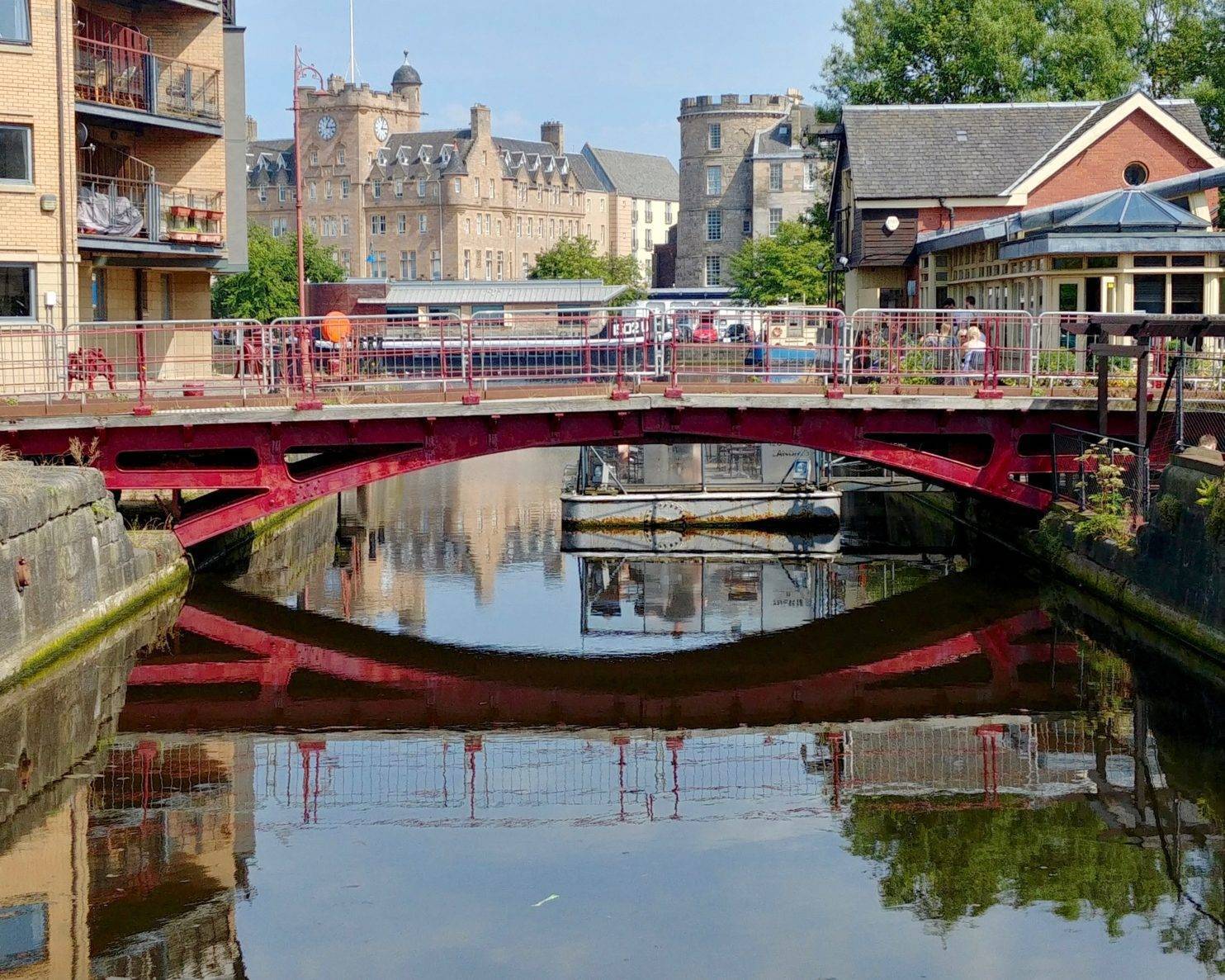Forth Ports applies for Listed Building Consent to Refurbish Leith’s Rennie’s Isle Bridge
Friday 25th February 2022
Forth Ports applies for Listed Building Consent to Refurbish Leith’s Rennie’s Isle Bridge

Forth Ports, in conjunction with Teuchters Landing, has submitted plans to the City of Edinburgh Council (CEC) for the refurbishment of the Category A-Listed Rennie’s Isle Swing Bridge located at the Water of Leith to conserve the landmark and bring the bridge back into use for the community.
The proposed programme of repair and refurbishment for the well-known bridge in Leith will ensure its structural integrity for the future, preserve its appearance and make it accessible for the community as a walkway.
The works will also create the opportunity for part of the bridge area to be utilised as an outdoor seating space as part of the Teuchter’s Landing public house located in Dock Place. An Application for Change of Use has been submitted to CEC for this purpose.
The swing bridge, named after the prominent Scottish engineer John Rennie, was constructed around 1800 as part of the design of Leith docks. Along with the nearby Victoria Swing Bridge – whose full refurbishment is already under way – these bridges were a key part of Rennie’s design of the docks in the 1800s.
The proposed refurbishment works for Rennie’s Isle Bridge includes: replacement of the timber structure, redecoration, installation of bollards, removal of trolley rails and installation of metal detail, installation of protective mesh and new timber blocks below existing railing uprights.
Commenting on the project, Charles Hammond, Group Chief Executive at Forth Ports, said: “The swing bridges in Leith are historical landmarks in the area and we are pleased to be able to submit plans to preserve Rennie’s Isle Bridge for the future. There is a great opportunity to create not only a usable walkway but also to create an attractive outdoor space at Teuchter’s Landing.”
John Tindal, Director of Teuchters (Edinburgh) LTD said: “We are very excited to bring the bridge back to its former glory, working closely with Forth Ports, allowing 24-hour access to the bridge which will be of huge relief to the local community and allowing us to utilise the bridge with very attractive and unique additional seating to our outdoor area with table service.”
25 February 2022 – ends –
About Rennie’s Isle Bridge:
The Old Docks, at the East entrance to which sits the present Rennie’s Lock Swing Bridge, were constructed between 1800 and 1817 by John Rennie. The present bridge is thought to have replaced an earlier timber swing bridge, however there is conflicting information on the construction date of the current iron bridge. While it is certainly to John Rennie’s design, broadly identical to those installed by John Rennie at the West India Docks in Wapping, London in 1804, it is not clear whether the one at Dock Place was installed by John Rennie himself during construction of the Old West Docks between 1810 and 1817, or whether it came later. John Rennie was a prominent Scottish civil engineer and he was also involved in the design of Leith docks, the Royal Ireland Canal, the Crinan Canal, Waterloo Bridge, London Bridge and the breakwater at Plymouth Sound amongst other notable structures.
Known modifications were made to the capstans and manual winch by James Leslie in 1846, and some sources suggest it was around this time that the present iron bridge was constructed circa. 1850. The bridge is 15 ft wide in two halves giving a clear span of 35 ft 6 in. with a skew of approximately 858. The overall length is 87 ft 3 in. The deck is timber with wrought-iron handrails and iron cart-wheel channels. Structurally the bridge is a three pin arch with six cast-iron ribs. It is opened by raising pivoted sections of the arch members adjacent to the springings by means of winches built into the deck; this frees the two halves of the bridge to rotate in plan. The drive mechanism is operated through capstans turning pinions which engage with racks fixed to the swing sections below road level.
About the Victoria Swing Bridge:
The construction of the Albert Dock (1862-1869) and Edinburgh Dock (1874-1881) to the East end of Leith Harbour made it necessary to provide an efficient road and railway route between docks on the East & West sides of the harbour and led to the construction of the Victoria Swing Bridge from 1871 to 1874. It was designed by Alexander Rendel, with alterations by Peter Whyte in 1896, and includes a pump house to the north. Rendel and Robertson Engineers also worked on both the East side docks throughout this period. The contractors for the foundations were McDonald & Grant and, for the bridge, Skerne Iron Works (late Pease, Hutchison & Co., Darlington who made the ironwork).
The Victoria Swing Bridge is constructed of riveted wrought-iron, timber and steel and carried a double rail track along its central deck whilst also providing vehicular access across its timber deck and pedestrian walkways to each side. Its girders, with an overall length of 212 ft and clear span of 120 ft, are made of wrought iron and the clear roadway width is 24 ft. The gross weight is 620 tons, including 60 tons of timber and 240 tons of kentledge counterweight which was, but is no longer, lifted and easily turned by means of hydraulic rams operated by the hydraulic power station [that was previously] located adjacent on the bank of the Alexandra Dry Dock. Its clear span is said to have been the largest of any swing bridge in the United Kingdom until the opening of Kincardine Bridge in 1937. The bridge remains the largest counterweighted swing bridge in Scotland. The bridge was closed to vehicular traffic in the mid-1990s. The timber deck of the bridge was renewed in 2000, on completion of which it was reopened to the public.
The Victoria Bridge is owned by Forth Ports Limited and is listed Category A by Historic Environment Scotland as a structure of national importance.
The bridge is currently undergoing a full repair programme by Forth Ports including:
- The full refurbishment of the northern and southern walkways
- Re-decking the central carriage way
- Replacement of the decked turning circle areas
- A full repair and repaint of metalwork on the bridge
